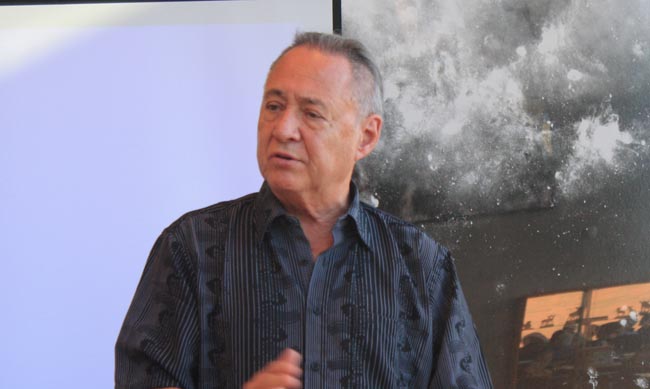You can’t learn if you don’t listen

By Maurice Switzer
There’s a story about how, after the dust cleared at the 1876 Battle of the Little Bighorn, Cheyenne and Lakota women scouring the battlefield for spoils of war came across the body of legendary Indian-killer George Armstrong Custer
They reached down and pierced Custer’s ears with needles, saying: “You didn’t hear us in this life – maybe you will in the next.”
A harsh lesson, to be sure, but one that resonates for indigenous peoples who still have trouble getting people to listen to what they have to say. It’s worse than simply disagreeing with Indigenous versions of history; it’s the outright refusal to acknowledge that there IS an Indigenous version.
Perhaps the most blatant example is the persistence of the theory that one day about 13,000 years ago people living in what is now Northeast Russia packed up their loincloths and started walking across an ice bridge that had frozen across the Bering Strait separating Asia from North America. Despite a growing mountain of scientific evidence to the contrary, this theory is still being taught as gospel in classrooms around the world.
Native Americans can’t get anybody to believe their Creation Stories, most of which say we have been here since the world began. To try and convince us otherwise is like telling Christians and Jews that God didn’t create Heaven and Earth – he bought them in a scratch-and-dent sale at Walmart.
It seems that any discussion that deals with Native topics quickly degenerates into nasty territory. So low has the level of public discourse sunk that the CBC has at least temporarily closed comments on indigenous-related stories.
“These stories draw a disproportionate number of comments that cross the line,” a spokesman said. “Some comments are clearly hateful and vitriolic, some are simply ignorant. And some appear to be hate disguised as ignorance.”
The last federal election may represent the dawn of a new era for the relationship between First Peoples and Canada. Now that a human being occupies the Prime Minister’s office, Indigenous peoples have high hopes that he will listen to what they have to say. So far Justin Trudeau is exceeding expectations, at least on the verbal front. He told hundreds of chiefs gathered in Ottawa that constitutionally-guaranteed rights of First Nations are “a sacred obligation”, in sharp contrast to his predecessor’s stance that they are merely a pain-in-the-ass.
Trudeau acted quickly on his promise to launch a public inquiry into why nearly 2,000 Indigenous women who have been murdered or gone missing in the past 30 years in Canada. He has also pledged to implement all 94 recommendations of the Truth and Reconciliation Commission, which spent six years analyzing the causes and effects of the notorious network of Indian Residential Schools.
Among the TRC’s most impactful recommendations are those calling for mandatory curriculum in Canadians classrooms about the country’s true history – the treaty relationships that enabled peaceful settlement by European immigrants; the pivotal role played by 10,000 Indian warriors in defending Canada against American invaders in the War of 1812; and, yes, the Residential Schools established by Canada to try and make Indigenous cultures and languages disappear, and from which one in five Native children never came home alive.
It’s in their classrooms that societies can hope to make lasting change and where, in Canada’s case, Reconciliation will start taking root.
Places of learning have not always been safe havens for the truth. James K. Bartleman recalls being the only Native student on the campus of the University of Western Ontario.
“I soon became aware that mainstream Canadians were uncomfortable with Indians,” says Ontario’s former Lieutenant Governor, a citizen of Rama First Nation.“I heard a professor tell our history class that all French-speaking Quebecers had some Indian blood as a result of their ancestors mixing with Aboriginal peoples during centuries of fur trading. To my shock, he went on to explain that this was the reason why Quebecers were so backward — neatly hitting two cultures with one racist stone.”
But even teachers are starting to recognize that Indigenous viewpoints are valid.
It was a recent honour for me to be the external examiner on the panel hearing Lesley Kimewon’s oral defence of her Master’s thesis: “Wampum Belts: All my Relations and the Seven Years’ War.” It was wonderful to hear Lesley – whose family ties are in Wikwemikong – speak with pride about how Indian leaders used amazing memories and oration skills to negotiate treaties with paper-oriented colonists. What was even more gratifying was to hear her praise her Nipissing University history professors for their support and encouragement, even though they saw history through a different lens.
She was specifically speaking about Dr. Nathan Kosuskanich and Dr. Katrina Srigley, who have more degrees between them than a thermometer, but who are not shy about admitting that a young First Nations woman just might have something to teach them.
Listening to what people say is the first step towards Reconciliation with them.
Maurice Switzer is a citizen of the Mississaugas of Alderville First Nation. He operates Nimkii Communications in North Bay and delivers public education presentations on Indigenous issues.

